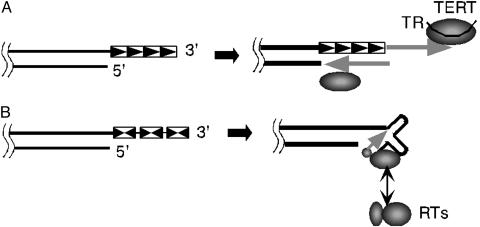Fig. 1.
The eukaryotic and bacterial solution to the problem of incomplete end replication. (A) In eukaryotes, telomeres consist of multiple copies of a direct repeat. To compensate for the loss of DNA incurred by incomplete replication of the strand with the 5′ end, eukaryotes use a special RT [telomerase RT (TERT)] to extend the strand with the 3′ end. The template for reverse transcription is embedded in an RNA (TR) that associates stably with TERT. The lengthened 3′ strand can then provide additional template residues for the synthesis of the 5′ strand by DNA polymerases. (B) In bacteria, telomeres consists of multiple inverted repeats. The 3′ overhang generated by incomplete end replication is presumed to fold into a structure that is recognized by a protein named Tap. The Tap protein can associate with Tpg, which is believed to provide the primer for the synthesis of the missing portion of the 5′ strand. The new article by Bao and Cohen (8) suggests that Tap is associated with two additional polypeptides with RT activity.

